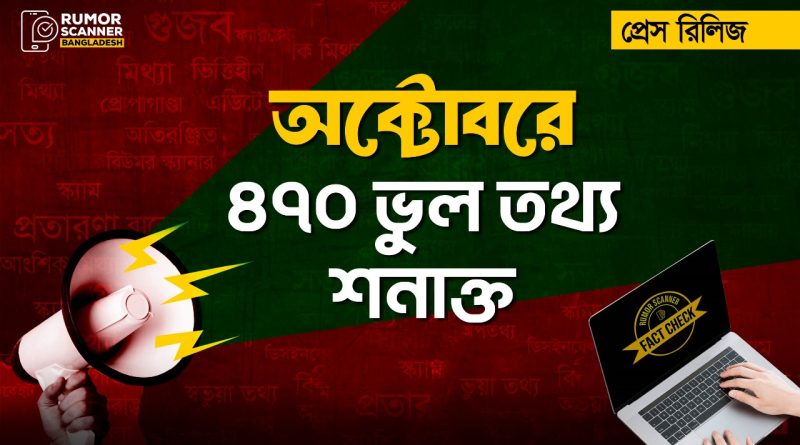In October of this year, Bangladeshi fact-checking organization Rumor Scanner identified 470 pieces of false information that spread across the internet. This marks the highest number of false information detections in a single month in Rumor Scanner’s history. The organization published fact-checks of these false claims through 363 reports on its website.
Analysis shows that political topics were the most common source of misinformation in October, accounting for 205 cases, or about 44% of all detected false information. Additionally, 94 were related to national issues, 85 to entertainment, 10 to religion, 38 to international issues, 26 to sports, four each to education and scams, and four to other topics. Beyond regular fact-checks, two statistical reports and three fact files were also published in October.
A breakdown of the identified misinformation shows that video-based false information was the most prevalent, totaling 280 cases. There were 111 data-based and 79 image-based false claims. Among these, 299 were categorized as false, 118 as distorted, 52 as misleading, and one as partially false.
Further analysis by Rumor Scanner found that 240 false claims involved men, while 172 involved women.
By age group, the misinformation was divided into four categories. The analysis showed that youths (aged 18–35) were linked to the highest number (162) of false information cases. In addition, four cases involved children (0–17 years), 126 involved middle-aged individuals (36–59 years), and 118 involved seniors (60 years and above).
In terms of platforms, Facebook was the most common source of misinformation in October, with 414 cases. This was followed by Instagram (136), TikTok (114), YouTube (68), X (formerly Twitter) (25), Threads (14), and one each on WhatsApp and LinkedIn. Traditional news media were not exempt either—Rumor Scanner identified 12 instances of false information being circulated through various Bangladeshi media outlets.
The spread of communal disinformation related to Bangladesh has been a topic of concern for several months. In October, Rumor Scanner identified 10 such cases, with half of them traced back to Indian social media accounts and pages spreading the false information.
Rumor Scanner’s monitoring revealed that seven false claims were spread in October involving the current interim government. To better understand the nature of these false claims, Rumor Scanner categorized them into two groups: positive misinformation (favoring the government) and negative misinformation (against the government). The analysis found that about 86% of these cases portrayed the government negatively.
A total of 23 false claims were spread about Dr. Muhammad Yunus, the Chief Adviser of the interim government, with around 96% portraying him negatively. Additionally, six false claims involved Press Secretary Shafiqul Alam, five each involved government advisers Dr. Asif Nazrul and Asif Mahmud Sajib Bhuiyan, and one involved Syeda Rizwana Hasan.
The 13th National Parliamentary Election has been widely discussed across the country, and misinformation related to it has increased in recent months. In October, 26 pieces of disinformation were identified in connection to the upcoming election.
Rumor Scanner’s analysis showed that among active political parties, Bangladesh Jamaat-e-Islami, its affiliates, and its leaders were the most frequent targets of disinformation—60 cases in total. Of these, 30 were about the party itself, about 57% of which carried negative narratives. The party’s student wing, Islami Chhatra Shibir, was associated with 21 false claims.
Next came the Bangladesh Nationalist Party (BNP), its affiliates, and its members, with 35 false claims detected. Of these, 18 were about BNP as a party—all portraying it negatively. Additionally, there were nine cases involving the Jatiyatabadi Chhatra Dal (student wing) and two involving the Jubo Dal (youth wing).
In October, 34 pieces of disinformation were found related to the National Citizen Party (NCP) and its members. Of these, 10 were about the party itself—all negative. The party’s convener, Nahid Islam, was linked to nine negative disinformation cases.
The banned party Bangladesh Awami League, along with its affiliated organizations and members, was the subject of 132 false information cases in October. Among them, 51 were about the party itself—all positive toward the party. 39 cases involved party president Sheikh Hasina, of which about 79% portrayed her positively. Additionally, 10 false claims involved the Bangladesh Chhatra League (student wing) and two involved the Jubo League (youth wing).
Even state security forces were not spared from misinformation. In October, Rumor Scanner detected 32 cases involving the Bangladesh Army, including 12 about Army Chief General Waker-uz-Zaman, and 12 cases involving the Bangladesh Police.
Analysis also revealed 143 pieces of AI-generated fake content, including 19 deepfakes, during the month.
There were nine major issues that dominated misinformation in October. Among them, fire incidents accounted for the highest number (25) of false claims. Additionally, there were 18 cases related to the Global Sumud Flotilla issue and 10 related to the Asia Cup.
Finally, the use of fake or doctored news cards, including fabricated media names, logos, and headlines, has been on the rise again. In October alone, 61 incidents involving such tactics were recorded, spreading 67 pieces of false information across 23 local and international news outlets.






